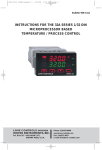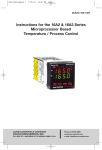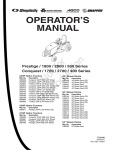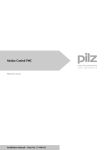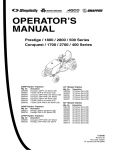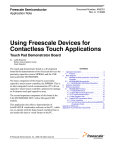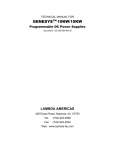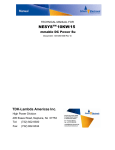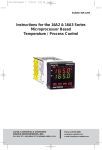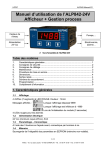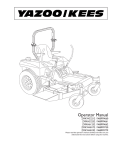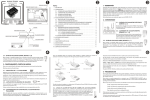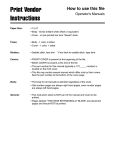Download 8600 - Dwyer Instruments, Inc.
Transcript
INSTRUCTIONS FOR THE 8600 SERIES MICROPROCESSOR BASED TEMPERATURE / PROCESS CONTROL LOVE CONTROLS DIVISION Dwyer Instruments, Incorporated ® December, 1998 PO Box 338 m Michigan City, IN 46361-0338 (800) 828-4588 m (219) 879-8000 m FAX (219) 872-9057 www.love-controls.com Page 1 949-1277-3 CONTENTS Installation ............................................................................................... 4 Wiring ...................................................................................................... 5 Wiring for Transmitter inputs ............................................................. 6 Wiring for 15 VDC Outputs ............................................................... 6 Wiring for Optional Inputs and Outputs ............................................. 7 Front Panel Key Functions ...................................................................... 8 Notation Conventions for the Menus ..................................................... 10 The Home Display ................................................................................. 11 Programming and Operation for Ramp / Soak feature .......................... 11 Theory of Operation .............................................................................. 11 Program Setup ...................................................................................... 12 Ramp / Soak Operation ......................................................................... 13 Auto / Manual Operation ....................................................................... 14 Operation of Self Tune® Function ......................................................... 15 Theory of Operation .............................................................................. 15 Program Setup and Operation .............................................................. 15 Operation and Programming of Options ................................................ 16 Menu Selections ................................................................................... 18 Primary Menu ........................................................................................ 18 Secondary Menu ................................................................................... 19 Secure Menu ......................................................................................... 26 Alarm Type and Action .......................................................................... 30 Diagnostic Error Messages ................................................................... 35 Specifications ........................................................................................ 37 Dimensions ............................................................................................ 40 © 1995, Love Controls Division, Dwyer Instruments, Incorporated. All rights reserved. No portion may be copied without the express written consent of Love Controls. 949-1277-3 Page 2 December, 1998 GETTING STARTED 1. Install the control as described on page 3. 2. Wire your control following the instructions on page 5. If you are using a two-wire transmitter as an input, see the drawing and instructions on page 6. Option wiring instructions are on Page 7. Option descriptions and specific instructions start on page 16. 3. Most controls do not need many (if any) program changes to work on your process. For best results when programming changes are necessary, make all the necessary changes in the Secure Menu (page 26) before making changes to the Secondary Menu (page 19). If error messages occur, check the Diagnostic Error Messages on page 35 for help. Take the example of a Model 86010 that comes from the factory programmed for type J thermocouples. Suppose for this example you wish to change the input to type K and limit the set point range between 0° and 1000° C. First, enter the Secure menu as instructed on page 5. Press the INDEX key until the display shows Inp and press the DOWN ARROW until the display shows CA. Don't forget to press the ENTER key to retain your setting. Next, press the INDEX key to display Unit. Press the DOWN ARROW until the display shows C. Press ENTER. Next, press the INDEX key until SPL is displayed (pass the dPt and InPt selections). Press the UP ARROW until the display shows 0. Press ENTER. Finally, press INDEX key to display SPH. Press the DOWN ARROW until the display shows 1000. Press ENTER. The necessary program changes are now complete. After 30 seconds the display will switch back to the temperature reading. If you want to return faster, press the UP ARROW and ENTER keys (at the same time) and then press the DOWN ARROW and INDEX keys ( again at the same time). This will 'back out' of the menu and immediately display the temperature reading. If you want to use Self Tune®, Auto/Manual, or the Ramp/Soak Programmer features, see the special sections on these items. Page numbers for these are in the Contents section on the previous page. December, 1998 Page 3 949-1277-3 MODEL IDENTIFICATION Model 8 6 Alarm 0 = No 1 = Yes — — — OPTIONS Output 1 1 = SSR 2 = 15 VDC Output 2 0 = None 3 = Relay 1 = SSR 5 = Current 2 = 15 VDC INSTALLATION 3 = Relay 5 = Current Orientation 0 = Vertical 1 = Horizontal Mount the instrument in a location that will not be subject to excessive temperature, shock, or vibration. All models are designed for mounting in an enclosed panel. Select the position desired for the instrument on the panel. Prepare the panel by cutting and deburring the required opening. From the front of the panel, slide the instrument through the cut out. The housing gasket should be against the housing flange before installing. From the rear of the panel slide the mounting collar over the housing. Hold the housing with one hand and using the other hand, push the collar evenly against the panel until the springs are compressed. The ratchets will hold the mounting collar and housing in place. PANEL CUTOUTS Vertical Horizontal 949-1277-3 Page 4 December, 1998 It is not necessary to remove the control chassis from the housing for installation. If the control chassis is removed from the housing, you must follow industry standard practice for control and protection against Electro-Static Discharge (ESD). Failure to exercise good ESD practices may cause damage to the control. WIRING Do not run thermocouple or other class 2 wiring in the same conduit as power leads. Use only the type of thermocouple or RTD probe for which the control has been programmed. Maintain separation between wiring of sensor, auxiliary in or out, and other wiring. See the "Secure Menu" for input selection. For thermocouple input always use extension leads of the same type designated for your thermocouple. For supply connections use No. 16 AWG or larger wires rated for at least 75°C. Use copper conductors only. All line voltage output circuits must have a common disconnect and be connected to the same pole of the disconnect. Input wiring for thermocouple, current, and RTD; and output wiring for 15 VDC is rated CLASS 2. Wiring to housing terminals while chassis is removed may cause distortion of the internal connector and possible damage to the connector when the chasis is reinstalled. It is strongly recomended that the control housing be wired with the chassis installed. Control wiring is as shown. + 11 + 2 12 - 3 13 4 14 1 21 T/C V RTD - + 6 7 8 9 NO ALARM 1 OUTPUT* C NO C 22 CURRENT 5 6 16 7 17 SET POINT 2 OUTPUT* 18 9 10 SET POINT 1 OUTPUT* 15 8 ALARM 2 OUTPUT* 24 VDC @ 50 mA ISOLATED SSR 15VDC pulsed + + - - + + - - RELAY NC 13 C 14 NO 15 NC 16 C 17 NO 18 19 23 24 20 F1 * IF SWITCHING INDUCTIVE LOADS (RELAYS, MOTORS, SOLENOIDS, ETC.) USE AN R/C SNUBBER ACROSS COIL. F1 = 3/8A 250VAC MEDIUM LAG UNUSED TERMINALS CAN NOT BE USED AS TIE POINTS FOR OTHER CIRCUITS. December, 1998 LINE INPUT SEE RATING LABEL FOR DETAILS Page 5 949-1277-3 Wiring for Transmitter inputs Wire power and outputs as shown on previous page. Two-wire transmitters wire as shown below. For three or four wire transmitters follow the wiring instructions provided with your transmitter. DO NOT WIRE THE 24 VOLT POWER SUPPLY ACROSS THE INPUT OF THE CONTROL. DAMAGE TO THE CONTROL INPUT CIRCUITRY WILL RESULT. Wiring for Optional Inputs and Outputs Wire power and outputs as shown on page 5. Wiring for options is shown opposite. All wiring shown below is Class 2. Shielded twisted pair is recommended for Option 992. DO NOT RUN SIGNAL WIRING IN THE SAME CONDUIT OR CHASE AS THE POWER WIRING. ERRATIC OPERATION OR DAMAGE TO THE CONTROL CIRCUITRY WILL RESULT. 949-1277-3 Page 6 December, 1998 OPTION 948 936 924 926 928 10 21 Sig. Ground Not Used Not Used Not Used Not Used 948 & 949 Truth Table 22 A to Gnd. B to Gnd. OPEN OPEN CLOSED OPEN OPEN CLOSED CLOSED CLOSED B A + + + CCW Wiper SP 1SP1 2SP1 3SP1 4SP1 SWITCH CONTACTS FOR OPTIONS 948 AND 949 MUST BE ISOLATED AND CAN NOT SHARE WIRING WITH OTHER CONTROLS. 1 21 22 11 2 12 3 13 4 14 5 15 6 16 7 17 8 18 RS-232 DB-25 WIRING (VIEWED FROM WIRE SIDE) DATA IN 23 DATA OUT 24 DATA GROUND 10 1 2 3 4 5 6 7 8 9 10 11 12 13 14 15 16 17 18 19 20 21 22 23 24 25 9 10 PIN 1 2 3 4 5 DESCRIPTION SHIELD TRANSMIT RECEIVE RTS CTS 24 DATA OUT 24 DATA IN 23 DATA GROUND 10 20 1 2 6 OPTION 992 993 949 10 Not Used Signal Ground Signal Ground December, 1998 DESCRIPTION DSR GROUND DCD DTR RS-232 DB-9 WIRING (VIEWED FROM WIRE SIDE) 19 23 PIN 6 7 8 20 23 3 7 4 8 5 9 PIN 1 2 3 4 5 6 7 8 DESCRIPTION DCD RECEIVE TRANSMIT DTR GROUND DSR RTS CTS 24 B A Data In Data Out A B Page 7 949-1277-3 FRONT PANEL KEY FUNCTIONS Set Point 1 Lamp Alarm Lamps Set Point 2 Lamp °F Indicator Process Display °C Indicator Set Point Display Remote Set Lamp Manual Indicator Per Cent Lamp Heater Break Indicator Hold Lamp The decimal point flashes when Self-Tune is operating. Key functions are as follows: INDEX: Pressing the INDEX key advances the display to the next menu item. May also be used in conjunction with other keys as noted below. UP ARROW: Increments a value, changes a menu item, or selects the item to ON. The maximum value obtainable is 9999 regardless of decimal point placement. DOWN ARROW: Decrements a value, changes a menu item, or selects the item to OFF. The minimum value obtainable is -1999 regardless of decimal point placement. ENTER: Pressing ENTER stores the value or the item changed. If not pressed, the previously stored value or item will be retained. The display will flash once when ENTER is pressed. AUTO/MANUAL: This key toggles the control output between Automatic mode and Manual mode. Press and hold key for three seconds to activate. See section on AUTO/MANUAL operation on Page 13. RUN/HOLD: This key toggles the Ramp/Soak programmer functions between Run mode (program runs as set up), and Hold mode (program functions are suspended). Press and hold key for three seconds to activate. See section on Programmer Functions (Page 10) for further details. 949-1277-3 Page 8 December, 1998 UP ARROW & ENTER: Pressing these keys simultaneously brings up the secondary menu starting at the alarm, tune, or cycle item (depending on programming). Pressing these keys for 5 seconds will bring up the secure menu. INDEX & DOWN ARROW: Pressing these keys simultaneously will allow backing up one menu item, or if at the first menu item they will cause the display to return to the primary menu. If an alarm condition has occurred, these keys may be used to reset the alarm. INDEX & ENTER: Pressing these keys simultaneously and holding them for 5 seconds allows recovery from the various error messages. The following menu items will be reset: ALiH: Alarm inhibit OPEn InP: Input error message bAd InP: Input error message CHEC CAL: Check calibration error Correct the problems associated with the above conditions before using these reset keys. More than one error could be present. Caution is advised since several items are reset at one time. While in the Primary or Secondary Menu, if no key is pressed for a period of 30 seconds, the display will return to the HOME position displaying the temperature value. While in the Secure Menu, if no key is pressed for a period of 60 seconds, the display will return to the HOME position displaying the temperature value. Outputs are disabled (turned off) when the Secure Menu is active. NOTE: To move to the Primary Menu quickly from any other menu, press the UP ARROW & ENTER keys followed by pressing the INDEX & DOWN ARROW keys. SECURITY LEVEL SELECTION Four levels of security are provided. The display shows the current security level. To change security levels change the password value using the UP & DOWN ARROW keys and pressing the ENTER key. Refer to the password table (following) for the correct value to enter for the security level desired. The SECr menu item security level may be viewed or changed at any time regardless of the present security level. To set the access level to, for example, 2, at the SECr menu item press the UP ARROW key until the upper display show the password, 1101. Press the ENTER key. The display will blink, and return with the level value, 2, in the upper display. December, 1998 Page 9 949-1277-3 The password values shown in the table cannot be altered, so retain a copy of these pages for future reference. This is the only reference made to password values in this instruction book. PASSWORD TABLE Menu Security Level Status Displayed Value When Viewed Password Value To Enter Primary Secondary Secure Locked Locked Locked 1 1110 Primary Secondary Secure Unlocked Locked Locked 2 1101 Primary Secondary Secure Unlocked Unlocked Locked 3 1011 Primary Secondary Secure Unlocked Unlocked Unlocked 4 111 NOTATION CONVENTIONS FOR THE MENUS Because of the number of features available in this control, information is included that may not apply to your specific control. All usable features are included in this book, but may not be used in your process. To increase clarity the following conventions are used: 1. Certain features or functions shown in this book are contextual. This means that Menu Items may or may not appear, depending on other Menu Item selections. Whenever this occurs, a notation is made in the Menu Item that "controls" or "directs" other menu items. If you are looking for a particular menu item and can't find it, check the menu item that is its "control" for proper setting. 2. The "#" symbol is used in two ways. It is used inside a group of characters to indicate which set point function (SP1 or SP2) is being affected. It is also used before a group of characters of a menu item to indicate that there may be more than one selection or value for that menu item. This is used for certain repeated items such as in the Ramp/Soak Program section. 949-1277-3 Page 10 December, 1998 THE HOME DISPLAY The home display is the normal display while the control is operating. If no errors or functions are active, the HOME display will indicate the Process Variable (the temperature, pressure, flow, RH, etc., that is being measured) on the top display and the Set Variable (Set Point 1) on the bottom. Items that can change the HOME display are the Auto/Manual function, the Run/Hold function, the Prog function, the PCtO function, and any error message. Description of these special displays follow. If the Auto/Manual key is pressed, the Manual indicator lights, and the home display is changed. The upper display continues to show the Process Variable (PV), but the lower display changes to show the percentage of output in tenths of a percent to 99.9% (0.0 to 99.9), or 100 if 100%. The display digit to the right of the number shows a flashing letter o to indicate that the value displayed is no longer the SV, but percent output. The SP2 output is indicated by the use of an overline on the letter õ. Access to the SP2 value is done by the INDEX key. See Auto/Manual Operation on Page 13 for further information. If Prog is turned On, the HOME display changes the SV display from SP1 to the Present Set Variable as calculated by the Ramp/Soak Programmer function. See Programming and Operation for Ramp/Soak Feature below for more information. If PCtO (Secondary Menu) is turned On, the lower display changes to show the active percentage of output as required to maintain SP1. The display is similar to the Auto/Manual display above, except that the letter indicators do not flash, and the output is displayed in whole percentages of output, not in tenths of a percent. If the control has both SP1 and SP2, the lower display will alternate between the SP1 percent output and the SP2 percent output. Error messages are listed on Page 35. PROGRAMMING AND OPERATION FOR RAMP / SOAK FEATURE The ramp / soak feature offers a great deal of flexibility by allowing changes in the set point to be made over a predetermined period of time. Dwell times can be programmed, and the alarm output relays can be programmed to open or close during any of the segments. Theory of Operation The 8600 Series controls offer a very simple approach to programming a ramp. Rather than requiring the operator to calculate an approach rate (usually in degrees per minute), the 8600 does the calculation internally. December, 1998 Page 11 949-1277-3 Thus, the operator only needs to program the target set point and the time desired to reach that point. When the ramp segment is executed by the control, it calculates the ramp required to move the process from the starting value (current PV) to the desired value (programmed SP) in the time allowed. Soaks (or dwells) are ramp segments where the target set point is the same as the beginning process value. This allows for multistage ramps without wasting intermediate soak steps. Care must be taken, however, that the process does actually reach the soak value before the soak time starts. If not, the next segment will calculate a slope from the starting PV to the target SP. Depending on your process requirements, this difference may be important. Make sure to test any program for desired results before running production material. Do not operate Self Tune while a ramp function is operating. The ramp function will prevent the Self Tune from operating properly. Make sure that all tuning is set up before operating Ramp / Soak. Program Setup All of the programming for the Ramp / Soak function is done in the Secondary Menu. You may wish to work out your program on paper before going into the programmer menu sequence. In the Secondary Menu INDEX to Prog and make sure that Prog is set to OFF. INDEX to PSEt and turn On. Skip the StAt setting (this is discussed later) and press INDEX to 1ti. The following items repeat in the following order: 1ti, 1SP, 1A1 (if alarm 1 is programmed as an event), 1A2 (if alarm 2 is programmed as an event), 2ti, 2SP, 2A1, 2A2, . . . , 16ti, 16SP, 16A1, 16A2. To avoid repetition each item will only be described once. Set 1ti to the amount of time you want for the first ramp. This value is in time units (determined by the tbAS menu item) from 0 to 9999. Press INDEX Set 1SP to the target value desired for the first ramp. This value is in actual units just like SP1. If the control is programmed for temperature, then the SP displays are in temperature. If the control is programmed for some other engineering unit, the SP is set in that unit. 949-1277-3 Page 12 December, 1998 Press INDEX to continue. If Alarm 1 is programmed as an event, then 1A1 will appear. If you wish the Alarm 1 contact to function for this segment, set 1A1 for On. If not, set for OFF. Press INDEX. If Alarm 1 is not programmed as an event, then 1A1 will not appear. If 1A1 is set to On, the Alarm 1 function will be active for the entire period as set in 1ti above. If Alarm 2 is programmed as an event, then 1A2 will appear. If you wish the Alarm 2 contact to function for this segment, set 1A2 for On. If not, set for OFF. Press INDEX. If Alarm 2 is not programmed as an event, then 1A2 will not appear. If Alarm 2 is not programmed as an event, then 1A2 will not appear. If 1A2 is set to On, the Alarm 2 function will be active for the entire period as set in 1ti above. Complete setting the segment times (2ti ... 16ti), segment set points (2SP ... 16SP), and event alarms (2A1 ... 16A1 and / or 2A2 ... 16A2) if they exist. For Unneeded or unused segments set the segment times (2ti ... 16ti) to 0, and set the segment set points (2SP ... 16SP) to the same value as the last active set point. Event alarms may be set to indicate "end of run" as you feel necessary. The last menu item for the ramp / soak function is PEnd. PEnd determines what the control does when the program has ended. You may choose to have the program repeat (LooP), Hold the last set point (16SP), revert to the local SP1, or turn the outputs off (OoFF). It is important to remember that if you want the program to repeat, you must allow the process to return to the same condition that existed when the program first started. Remember that the ramp function calculates the slope by drawing a line from the beginning PV to the ramp target set point. If the PV at the end of the program is different than the PV at the initial start, the ramp will calculate differently. Ramp / Soak Operation When you wish to start the program, enter the Secondary Menu and set the Prog menu item to On. Return to the HOME position by waiting for the display to time out or by pressing the UP ARROW / ENTER keys and then the DOWN ARROW / INDEX keys. The home display will read as it normally does. The HOLD indicator over the RUN / HOLD key will be lit. To start the program press the RUN / HOLD key. The HOLD indicator will go out, and the program will start. December, 1998 Page 13 949-1277-3 To suspend the program at any time, press the RUN / HOLD key. Press the key again to resume. Pressing the AUTO / MANUAL key will also suspend the program operation. The difference is that AUTO / MANUAL also puts the control into manual mode. See Auto / Manual Operation on page 13. The function of the Primary Menu will change depending on the setting of the StAt menu item in the Secondary Menu. If StAt is OFF then the Primary Menu is not changed. If the StAt menu item is set to On, then the Primary Menu has three additional information items added before SP1 appears. The first INDEX item, ####/ ti, displays the time remaining in the current segment. The next INDEX item, ####/##ti, displays the total time for the active segment (1ti...16ti). The third INDEX item, ####/##SP, displays the segment set value (1SP...16SP). The next INDEX press resumes the normal Primary Menu AUTO / MANUAL OPERATION The AUTO / MANUAL function allows you to manually adjust the output of the control. This is normally used during process setup or start up. It can also be used for troubleshooting. To switch from AUTO to MANUAL press the AUTO / MANUAL key. The MANual indicator will light and the lower display will change from normal to showing the actual output in percent. The value will be the actual percentage of output that was active when the key was pressed. This is usually known as "bumpless transfer". If you wish to change the output while in manual, press the UP ARROW or DOWN ARROW keys to change the value, and press ENTER to retain it. It is important to remember that the value of the display is read as 0 to 100% of the full control output, NOT the range between S1OL and S1OH or S2OL and S2OH. For example, if the set point one output is programmed for 4 to 20 mA (S1OL=20, S1OH=100), a reading of 50% in MANUAL represents 10 mA, not 12mA. This allows the operator to go above and below the output range to allow for improperly function equipment that may be connected to the control output. To return to AUTOmatic control, press the AUTO / MANUAL key again. The MANual indicator will go out, and the set point will take over. If you want bumpless transfer back to AUTO, slowly change the percentage of output until the process variable matches (or at least is close) to the set point. The further away the PV is from the set point, the greater the "bump" or upset there will be in the output. 949-1277-3 Page 14 December, 1998 OPERATION OF SELF TUNE® FUNCTION Self Tune® allows automatic selection of the necessary parameters to achieve best control operation from your 8600 Series control. If you are using the control output as a simple on-off function (Out1 set for OnOF), none of the following will apply. Theory of Operation The Self Tune function calculates the Pb1, rES, and rtE parameters under the PID tunE selection, and the Fbnd and FrtE parameters, as shown in the Secondary Menu . These values are determined by measuring the response of the process connected to the control. When Self Tune is started, the control temporarily acts as an on-off control. While in this mode the control measures the overshoot and undershoot of the process, and the period of the process (the time from peak value to the next peak value). These measurements are collected over a period that lasts three periods of overshoot and undershoot. The data collected over this time is then compared and calculated into final PID and Fuzzy Logic values. The effect of Fuzzy Logic on the process is still controlled by the Fint (fuzzy intensity) setting. If Fint is 0, the Fbnd and FrtE will be calculated, but will have no effect. The calculations for the PID values are the same as used in the standard Ziegler - Nichols equations that have been recognized as standard for decades. The only modification to the application of the Ziegler - Nichols equations is controlled by the dFAC menu item. This menu item controls the amount of rate (derivative) that is applied. A dFAC setting of 3 (factory default) or less allows for less damping. A dFAC setting of 4 allows for critical damping as set forth in Ziegler - Nichols. A dFAC setting of 5 or more allows over damping of the process. Program Setup and Operation In the secondary menu set tunE to SELF. Skip LErn and check to make sure that dFAC is set to the desired value. Back up to LErn and set to YES. The control will begin the Self Tune function. While the Self Tune function is active, the right hand decimal point on the lower display will blink. When Self Tune is complete, the blinking will stop. After Self Tune is complete, the tunE setting automatically switches to PID. This allows examination and / or modification of the values calculated. We recommend that you do not change the calculated values unless you have a firm understanding of the parameters involved and their function. For more information on PID tuning, please contact your supplier. December, 1998 Page 15 949-1277-3 OPERATION AND PROGRAMMING OF OPTIONS Options 924, 926, 928, Analog Remote Set Point The analog remote set point allows the control set point to be determined by an outside analog signal. The signal may be 0 to 10 VDC (Option 924), 0 (or 4) to 20 mADC (Option 926), or 0 to 10,000 Ohms (Option 928). Wire the input as shown on page 7. To set up the analog remote set point, first determine the scale range that the analog signal will represent. The maximum span is 11,998 degrees or counts. In the Secure Menu set rSCL for the scale value that will be represented by the low end of the analog signal (0 Volts, 0 mA, 0 Ohms). Set rSCH for the scale value that will be represented by the high end of the analog signal (10 Volts, 20 mA, 10,000 Ohms). If you require a suppressed scale or input, you may use the following equations to determine the proper settings for rSCL and rSCH. K = (Highest desired scale reading - Lowest desired scale reading) / (Maximum desired analog signal - Minimum desired analog signal). rSCH = ((Maximum possible analog signal- Maximum desired analog signal) * K) + Highest desired analog reading. rSCL = Lowest desired scale reading - ((Minimum desired analog signal) * K). Operation is simple. Make sure that a valid analog signal is available to the control. In the Secondary Menu set the rSPt to On. The REM indicator on the front of the control will turn on. When the control returns to the HOME position, the displayed SV will be the value supplied from the analog remote signal. If the analog remote signal fails or goes out of range of the SPL or SPH settings, the control will revert to the internal SP1 (or #SP1), and flash the error message CHEC rSPt. If SPL or SPH are set outside of rSCL or rSCH then the error will be suppressed, and the control will attempt to work with the remote value. To clear the error message, change rSPt to OFF. Option 934, 936, Analog Retransmission. The analog retransmission option allows the Process Variable or the Set Variable to be sent as an analog signal to an external device. The signal may be either 0 to 10 VDC (Option 936) or 0 (or 4) to 20 mADC (Option 934). The output may be changed in the field from one to the other by the toggle switch located on the top printed circuit board. Wire the output as shown on page 7. 949-1277-3 Page 16 December, 1998 To set up the analog retransmission, first determine the scale range that the analog signal will represent. The maximum scale is 9999°F, 5530°C, or 9999 counts. In the Secondary Menu set POL for the scale value that will be represented by the low end of the analog signal (0 Volts or 0 mA). Set POH for the scale value that will be represented by the high end of the analog signal (10 Volts or 20 mA). If you require a suppressed scale or output, you may use the following equations to determine the proper settings for POL and POH. K = (Highest desired scale reading - Lowest desired scale reading) / (Maximum desired analog signal - Minimum desired analog signal). POH = ((Maximum possible analog output - Maximum desired analog signal) * K) + Highest desired analog reading. POL = Lowest desired scale reading - ((Minimum desired analog output) * K). Next select whether you want the retransmission signal to follow the Process Variable or the Set Variable. Usually the Process Variable is sent to recorders or other data acquisition devices. Usually the Set Variable is sent to other controls to be used as an analog remote set point. If you want the analog retransmission signal to follow the PV, in the Secondary Menu set POSr to InP. If you want the analog retransmission signal to follow the SV, set POSr to SPt. Operation is automatic. There are no further programming steps required. Option 948, 4-Stage Set Point. The 4-stage set point option allows four different values to be used for SP1 and all of the values associated with the tunE menu items. The control will switch to a given stage when an external contact or contacts are made or opened across the appropriate terminals at the rear of the control (when SPSA, Set Point Switch Action, is set for remote, rE), or when the stage is selected from the Secondary Menu, SP (when SPSA is set for Int). When the state of a contact changes (or the stage number is changed in the Secondary Menu), the values in use are stored and the previously stored values for the new stage are used. Wire the input as shown on page 7. Usually the control is configured for external switching of the stages. In this case, the operation is usually automatic, selected by the external switches driven by the machine logic. If it is necessary to program the stages in advance, you may select the stage to modify with the SP menu item. When SP is changed while the SPSA is set for rE, the selected stage is displayed for modification, but only used when the appropriate contact is made. December, 1998 Page 17 949-1277-3 Option 992, 993, Serial Communication. The serial communications options allow the control to be written to and read from a remote computer or other similay digital device. Communication is allowed either through a RS-485 (Option 992) port, or a RS-232 (Option 993) port. Wire the communication lines as shown on Page 7. Wiring for the RS-485 is run from control to control in a daisy chain fashion with a termination resistor (120 ohms) across the transmit and receive terminals of the last control in the chain. Select the control address and communication baud rate with the Addr and bAUd menu items in the Secure Menu. THE BAUD RATE AND ADDRESS MENU ITEMS WILL TAKE EFFECT ON THE NEXT POWER UP OF THE CONTROL. BE SURE TO POWER CYCLE THE CONTROL BEFORE USING THE NEW BAUD RATE AND ADDRESS. In operation, you have the option of preventing a write command from the host computer. To prevent the host from writing to the control change the LOrE menu item in the Secondary Menu to LOC. To allow the host to write commands to the control set LOrE to rE. (The host does have the ability to change the LOrE state, but it is not automatic.) If your system depends on constant reading or writing to and from the host, you may wish to set the No Activity Timer (nAt) to monitor the addressing of the control. When the LOrE is set to rE and the nAt is set to any value other than Off, the control will expect to be addressed on a regular basis. If the control is not addressed in the time set by the value of nAt, then the control will display the error message CHEC LOrE. To clear the message set LOrE to LOC. MENU SELECTIONS PRIMARY MENU Press INDEX to advance to the next menu item. Press UP ARROW or DOWN ARROW to change the value in the display. Press ENTER to retain the value. If StAt (Secondary Menu) is On, the three program status menu items will precede the following. #SP1 SP1 (Option 948, 4-Stage Set Point) or Set Point 1 Adjust, Control Point 1. SP2 Set Point 2 Adjust (if equipped), Control Point 2. 949-1277-3 Page 18 December, 1998 SECONDARY MENU Hold UP ARROW & ENTER. Press INDEX to advance to the next menu item. Press UP ARROW or DOWN ARROW to change the value in the display. Press ENTER to retain the value. A1Lo Alarm 1 Low: The Low Alarm point is usually set below the Set Point. May not appear depending on AL1 setting in Secure Menu. A1Hi Alarm High: The High Alarm Point is usually set above the Set Point. May not appear depending on AL1 setting in Secure Menu. A2Lo Alarm 2 Low: The Low Alarm point is usually set below the Set Point. May not appear depending on AL2 setting in Secure Menu. A2Hi Alarm 2 High: The High Alarm Point is usually set above the Set Point. May not appear depending on AL2 setting in Secure Menu. Out1 Output selection: Select OnOf, 1tP, 1PuL, or ProP. ONOF A setting of ONOF allows the control to operate as a simple on/off mode. This setting forces the control to turn off at set point, and on at the set point plus the differential (SP_d). When selected, the Out1/OnOF menu item is followed by ####/SP1d, and the tunE, Pb, rES, OFS, rtE, and ArUP selections in the Secondary menu and the S1OL and S1OH selections in the Secure menu are suppressed. SP_d Set Point On-Off Differential (hysteresis). Select 1 to 9999 (direct acting), or -1 to -9999 (reverse acting). This value will be negative for reverse acting set points, and positive for direct acting outputs. Set the value for the amount of difference between the turn off point (set point) and the turn on point. The following drawing shows output behavior for reverse and direct action. ##tP Time Proportioning Cycle Time. Select 1tP to 80tP. 1tP A setting of 1tP is recommended for solid state outputs (SSR or 15VDC). 2tP to 80tP Time Proportioning Control is adjustable in 1 second steps. Recommended for mechanical outputs (relays, solenoids, etc.). For best contact life, a time should be selected as long as possible without causing the process to wander. #PuL Pulsed Time Proportioning Output: Select 1PuL December, 1998 Page 19 949-1277-3 ProP to 7PuL. 1PuL = Linear and 7PuL = most nonlinear. Changes output linearity for use in cooling applications or for an extremely fast response processes. At the center of the proportional band, a pulse value of 1 provides an output of one second on and one second off (50% output). A pulse value of 2 provides an output of one second on and two seconds off (33% output). Output at center of band equals one second on, 2(pulse value-1) seconds off. For Current (Code 5) outputs only. The following menu items apply only if your control is equipped with a second set point (last digit of model number is not zero). If your control does not have a second set point, jump to the "tunE" menu on the next page. Out2 Output selection: Select OnOf, 2tP, 2PuL, or ProP. ONOF A setting of ONOF allows the control to operate as a simple on/off mode. This setting forces the control to turn off at set point, and on at the set point plus the differential (SP2d). When selected, the Out2/OnOF menu item is followed by ####/SP2d, and the Pb2 selection in the Secondary menu and the S2OL and S2OH selections in the Secure menu are suppressed. SP2d Set Point On-Off Differential (hysteresis). Select 1 to 9999 (direct acting), or -1 to -9999 (reverse acting). This value will be negative for reverse acting set points, and positive for direct acting outputs. Set the value for the amount of difference between the turn off point (set point) and the turn on point. The drawing opposite shows output behavior for reverse and direct action. ##tP 949-1277-3 Time Proportioning Cycle Time. Select 1tP to 80tP. 1tP A setting of 1tP is recommended for solid state outputs (SSR or 15VDC). Page 20 December, 1998 ProP 2tP to 80tP Time Proportioning Control is adjustable in 1 second steps. Recommended for mechanical outputs (relays, solenoids, etc.). For best contact life, a time should be selected as long as possible without causing the process to wander. #PuL Pulsed Time Proportioning Output: Select 1PuL to 7PuL. 1PuL = Linear and 7PuL = most nonlinear. Changes output linearity for use in cooling applications or for an extremely fast response processes. At the center of the proportional band, a pulse value of 1 provides an output of one second on and one second off (50% output). A pulse value of 2 provides an output of one second on and two seconds off (33% output). Output at center of band equals one second on, 2(pulse value-1) seconds off. For Current (Code 5) outputs only. SP (Option 948, 4-Stage Set Point) Active Set Point Stage. Select 1SP1, 2SP1, 3SP1, 4SP1. 1SP1 Set Menu Items to display Stage 1 for view and change access. If SPSA is set for Int, 1SP1 is made active. 2SP1 Set Menu Items to display Stage 2 for view and change access. If SPSA is set for Int, 2SP1 is made active. 3SP1 Set Menu Items to display Stage 3 for view and change access. If SPSA is set for Int, 3SP1 is made active. 4SP1 Set Menu Items to display Stage 4 for view and change access. If SPSA is set for Int, 4SP1 is made active. #SP1 (Option 948, 4-Stage Set Point) Adjust Control Point 1 for Stage selected above. Note: The menu items for tunE (below) are modified when Option 948 is in use. When Option 948 is active the menu items are preceeded with the stage number selected in SP above. The stage number is noted here with the # sign. When the 4 Stage Set Point option (948) is active, each stage has its own set of tunE parameters. #tun tunE (Option 948, 4-Stage Set Point) or Tuning Choice: Select SELF, Pid, SLO, nor, or FASt. SELF The Controller will evaluate the Process and select the PID values to maintain good control. Active for SP1 only. LErn Select YES or no December, 1998 Page 21 949-1277-3 YES Pid SLO nor FASt Start Learning the Process. After the process has been learned the menu item will revert to no. no Learning will stay in present mode. dFAC Damping factor, Select OFF, 1 to 7. Sets the ratio of Rate to Reset for the SELF tunE mode. 7 = most Rate. Factory set to 3. For a fast response process the value should be lowered (less Rate). For a slower process the value should be increased (more Rate). Manually adjust the PID values. PID control consists of three basic parameters, Proportional Band (Gain), Reset Time (Integral), and Rate Time (Derivative). #Pb1 (Option 948, 4-Stage Set Point) or Pb1 Proportional Band (Bandwidth). Select 1 to 9999 °F, °C, or counts. Pb2 Proportional Band (Bandwidth). Select 1 to 9999 °F, °C, or counts. Appears only if control is equipped with second set point and Out2 is NOT selected as ONOF. #rES (Option 948, 4-Stage Set Point) or rES Automatic Reset Time. Select OFF, 0.1 to 99.9 minutes. Select OFF to switch to OFS. #OFS (Option 948, 4-Stage Set Point) or OFS Manual Offset Correction Select OFF, 0.1 to 99.9%. Select OFF to switch to rES. #rtE (Option 948, 4-Stage Set Point) or rtE Rate Time. Select OFF, 0.01 to 99.99 minutes, Derivative. PID values are preset for a slow response process. PID values are preset for a normal response process. PID values are preset for a fast response process. Pid2 Linkage of PID parameters between SP1 and SP2: Select On or OFF. On Applies SP1 rEs, rtE, Fbnd, and FrtE terms to SP2 for heat/cool applications. OFF SP2 functions without rEs, rtE, Fbnd and FrtE. ArUP Anti- Reset Windup Feature: Select On or OFF. On When ArUP is On the accumulated Reset Offset value will be cleared to 0% when the process input is not within the Proportional Band. OFF When ArUP is OFF, the accumulated Reset Offset Value is retained in memory when the process input is 949-1277-3 Page 22 December, 1998 not within the Proportional Band. ArtE Approach Rate Time: Select OFF, 0.01 to 99.99 minutes. The function defines the amount of Rate applied when the input is outside of the Proportional Band. The ArtE time and the rtE time are independent and have no effect on each other. To increase damping effect and reduce overshoot set the approach rate time for a value greater than the natural rise time of the process (natural rise time = process value time to set point). Fint Fuzzy Logic Intensity: Select 0 to 100%. 0% is OFF (disables Fuzzy Logic). The function defines the amount of impact Fuzzy Logic will have on the output. Fbnd Fuzzy Logic Error Band: Select 0 to 4000 °F, °C, or counts. Sets the bandwidth of the Fuzzy Logic. Set Fbnd equal to PID proportional band (Pb1) for best results. FrtE Fuzzy Logic Rate of Change: Select 0.00 to 99.99 counts/second. For best initial setting, find the count/second change of process value near set point 1 with output ON 100%. Multiply this value by 3. Set FrtE to this calculated value. PEA The Peak feature stores the highest input the control has measured since the last reset or Power On. At Power On PEA is reset to the present input. To manually reset the value PEA must be in the lower display. Press the ENTER key to reset. PEA will be reset and display the present input value. UAL The Valley feature stores the lowest input the Instrument has measured since the last reset or Power On. At Power On UAL is reset to the present input. To manually reset the value UAL must be in the lower display. Press the ENTER key. UAL will be reset and display the present input value. PctO Percent Output Feature: Select On or OFF. On When selected On, the HOME lower display will indicate the output of the controller in percent. An “o” will appear in the right hand side of the lower display to indicate percent output for SP1. An "õ" will appear on the right hand corner of the lower display to represent percent output for SP2, if the control is so equipped. The display will alternate between these values. OFF Percent Output display is disabled. December, 1998 Page 23 949-1277-3 Prog Ramp/Soak Feature: Select On or OFF On Allows Programmed Ramp/Soak function to be started by the Run/Hold key on the control front panel. OFF Turns Ramp/Soak function OFF and resets program to beginning. PSEt Programmer function set. Select On or OFF. Off Skip Ramp/Soak Programming. Go to next Secondary Menu Item, InPC on the next page. On Enable Ramp/Soak Programming. StAt Programmer Status Display in the Primary Menu when Prog (above) is On: Select On or OFF. OFF The Primary Menu operates as normal. On The Primary Menu is altered to have the following items inserted before the SP1 menu item: ####/ti (time remaining in segment), ####/##ti (total time in active segment), and ####/##SP (segment target set point). tbAS Ramp/Soak Time Base. Select 1_S or 60_S. 1_S Ramp/Soak time base is in 1 second increments. Program time 1ti...16ti is measured in seconds. 60_S Ramp/Soak time base is in 60 second increments (minutes). Program time 1ti...16ti is measured in minutes. The following items repeat in the following order: 1ti, 1SP, 1A1 (if alarm 1 is programmed as an event), 1A2 (if alarm 2 is programmed as an event), 2ti, 2SP, 2A1, 2A2, . . . , 16ti, 16SP, 16A1, 16A2. To avoid repetition each item will only be described once. 1ti Segment Time: Select 0 to 9999 units (minutes if tbaS is set to 60_S, seconds if tbaS is set to 1_S. 1SP Segment Set Point: Select value as desired. 1A1 Segment Alarm 1 Event: Select On or OFF . On Alarm 1 is active during segment 1 time (1ti). OFF Alarm 1 is inactive during segment 1 time (1ti). 1A2 Segment Alarm 2 Event: Select On or OFF. On Alarm 2 is active during segment 1 time (1ti). OFF Alarm 2 is inactive during segment time (1ti). 949-1277-3 Page 24 December, 1998 PEnd Program End action: Select Hold or OoFF. Hold Stay at the Present Set Point (16SP). OoFF Turn Off SP1 and SP2 Outputs at the end of the program. LooP Repeat program starting at 1ti. SP1 Revert to SP1 value. InPC Input Correction: Select ±500 °F, °C, or counts. This feature allows the input value to be changed to agree with an external reference or to compensate for sensor error. Note: InPC is reset to zero when the input type is changed, or when decimal position is changed. FiLt Digital Filter: Select OFF, 1 to 99. In some cases the time constant of the sensor, or noise could cause the display to jump enough to be unreadable. A setting of 2 is usually sufficient to provide enough filtering for most cases, (2 represents approximately a 1 second time constant). When the 0.1 degree resolution is selected this should be increased to 4. If this value is set too high, controllability will suffer. LPbr Loop Break Protection: Select OFF, 1 to 9999 seconds. If, during operation, the output is minimum (0%) or maximum (100%), and the input moves less than 5°F (3°C) or 5 counts over the time set for LPbr, the LOOP bAd message will appear. This condition can also be routed to an Alarm Condition if alarms are present and turned On (see ALbr in the secure menu). The loop break error can be reset by pressing the ENTER key when at the LPbr menu item. The INDEX & ENTER keys may also be used. POL (Option 934, 936, Analog Retransmission Output) Process Output Low: Select -450°F, -260°C, or -1999 counts to any value less than POH. POH (Option 934, 936, Analog Retransmission Output) Process Output High: Select from any value greater than POL to +9999°F, +5530°C, or 9999 counts. POSr (Option 934, 936, Analog Retransmission Output) Process Output Source: Select InP or SPt. InP Process output follows the Process Variable (input). SPt Process Output follows the Set Variable (SP1). December, 1998 Page 25 949-1277-3 rSPt (Option 924, 926, 928, Analog Remote Set Point) Remote Set Point: Select On or OFF. OFF The control uses the value set for SP1. On The control uses the value set by the analog remote set point signal as established by the Secure Menu items rSCL and rSCH. If the analog signal fails, the control will display the error message CHEC/ LorE and revert to the SP1 local value. LOrE (Option 992, 993, Serial Communications) Local / Remote Status: Select LOC or rE. LOC The host computer is advised not to send remote commands. Any write commands sent to the controls will be rejected. rE The host computer is allowed to send write commands.If the control is not addressed within the time set in the nAt (No Activity Timer, see Secure Menu) the CHEC LorE error message will be displayed. Addr (Option 992, Serial Communications) Control Address: Set from 1 to 3FF. This number (hexadecimal, base 16) must match the address number used by the host computer. Viewed only in this menu. To change this parameter, see Addr in the Secure Menu. SECURE MENU Hold UP ARROW & ENTER for 5 Seconds. Press INDEX to advance to the next menu item. Press UP ARROW or DOWN ARROW to change the value in the display. Press ENTER to retain the value. OUTPUTS ARE DISABLED (TURNED OFF) WHILE CONTROL IS IN SECURE MENU. SECr Security Code: See the Security Level Selection and the Password Table in this manual, in order to enter the correct password. InP Input Type: Select one of the following. Refer to the Input wiring section for the proper wiring. J-IC Type “J” Thermocouple CA Type “K” Thermocouple EType “E” Thermocouple tType “T” Thermocouple LType “L” Thermocouple nType “N” Thermocouple r-13 Type “R” Thermocouple S-10 Type “S” Thermocouple bType “B” Thermocouple 949-1277-3 Page 26 December, 1998 CP392 n120 P385 1P38 Curr VoLt diFF ---- Type “C” Thermocouple 100 ohm Platinum (NIST 0.00392 Ω/Ω/°C) 120 ohm Nickel 100 ohm Platinum (DIN 0.00385 Ω/Ω/°C) 1000 ohm Platinum (DIN 0.00385 Ω/Ω/°C) DC Current Input 0.0 to 20.0 or 4.0 to 20.0 mA. DC Voltage Input 0.0 to 10.0 or 2.0 to 10.0 volts. DC Voltage Input -10 to +10 mV. Reserved OSUP Zero Suppression: Select On or OFF. Only with Current and Voltage input types. OFF The input range will start at 0 (zero) Input. On The input range will start at 4.00 mA or 2.00 V. Unit F, C or None. F °F descriptor is On and temperature inputs will be displayed in actual degrees Fahrenheit. C °C descriptor is On and temperature inputs will be displayed in actual degrees Celsius. nonE °F and °C descriptors will be Off. This is only available with Current and Voltage Inputs. dPt Decimal Point Positioning: Select 0, 0.0, 0.00, or 0.000. On temperature type inputs this will only effect the Process Value, SP1, SP2, ALLo, ALHi, and InPC. For Current and Voltage Inputs all Menu Items related to the Input will be affected. 0 No decimal Point is selected. This is available for all Input Types. 0.0 One decimal place is available for Type J, K, E, T, L, RTD’s, Current and Voltage Inputs. 0.00 Two decimal places is only available for Current and Voltage Inputs. 0.000 Three decimal places is only available for Current and Voltage inputs. InPt Input Fault Timer: Select OFF, 0.1 to 540.0 minutes. Whenever an Input is out of range (UFL or OFL displayed), shorted, or open the timer will start. When the time has elapsed, the controller will revert to a safe condition (Output Off, Flashing Display). If OFF is selected, the Input Fault Timer will not be recognized (time = infinite). SEnC Sensor Rate of Change: Select OFF, 1 to 4000 °F, °C, or counts per 1 second period. This value is usually set to be slightly greater December, 1998 Page 27 949-1277-3 than the fastest process response expected during a 1 second period, but measured for at least 2 seconds. If the process is faster than this setting, the SEnC bAd error message will appear. The outputs will then be turned off. This function can be used to detect a runaway condition, or speed up detection of an open thermocouple. Use the INDEX & ENTER keys to reset. SCAL Scale Low: Select 100 to 9999 counts below SCAH. The total span between SCAL and SCAH must be within 11998 counts. Maximum setting range is -1999 to +9999 counts. For Current and Voltage inputs, this will set the low range end. Viewable only for Thermocouple and RTD ranges. SCAH Scale High: Select 100 to 9999 counts above SCAL. The total span between SCAL and SCAH must be within 11998 counts. Maximum setting range is -1999 to +9999 counts. For Current and Voltage inputs, this will set the high range end. Viewable only for Thermocouple and RTD ranges. SPL Set Point Low: Select from the lowest input range value to SPH value. This will set the minimum SP1 or SP2 value that can be entered. The value for SP1 or SP2 will not stop moving when this value is reached. SPH Set Point High: Select from the highest input range value to SPL value. This will set the maximum SP1 or SP2 value that can be entered. The value for SP1 or SP2 will not stop moving when this value is reached. S1St Set Point 1 State: Select dir or rE. dir Direct Action. As the input increases the output will increase. Most commonly used in cooling processes. rE Reverse Action. As the input increases the output will decrease. Most commonly used in heating processes. If Out1 is set for ##tP, #PUL, or ProP,then S1OL and S1OH (following) appear. If Out1 is set for ONOF, then skip to S1rE. S1OL Set Point Output Low Limit: Select 0 to 100% but not greater than S1OH. This item limits the lowest output value. This is useful for adding a bias to the process when needed. Factory set to 0 for output codes 1,2, and 3. Factory set to 20 for output code 5 (20% output equals 4 mA output). 949-1277-3 Page 28 December, 1998 S1OH Set Point 1 Output High Limit: Select 0 to 100% but not less than S1OL for output codes 1, 2, or 3. Select 0 to 102% but not less than S1OL for output code 5. This item allows setting the maximum output limit. This is useful with processes that are over powered. Adjustment to 102% allows setting current output to force a full on condition for output devices which do not have bias adjustments. Factory set to 100 for all output codes. If Out1 is set for ##tP, #PUL, or ProP,then skip to S1LP below. S1rE Set Point 1 Reset. Select OnOF or Hold. OnOF Control will automatically reset when process passes back through SP1d. HoLd Manual Reset. Reset (acknowledge) by simultaneously pressing the INDEX & DOWN ARROW keys for 5 seconds. S1Pi Set Point 1 Power Interrupt. Select On or OFF. On Alarm Power Interrupt is On. Control will automatically reset on power-up if no alarm condition exists. OFF Alarm Power Interrupt is OFF. Control will power-up in alarm condition regardless of condition of process. S1iH Set Point 1 Inhibit: Select On or OFF. On Alarm Inhibit is On. Alarm action is suspended until the process value first enters a non-alarm condition. OFF Alarm Inhibit is OFF. S1LP Set Point Lamp: Select O on or OoFF. O on Lamp ON when Output is ON. OoFF Lamp OFF when Output is ON. If your control is not equipped with Set Point 2, then proceed to the alarm section (next page). S2t Set Point 2 type: Select Abs or dE. AbS Absolute SP2. SP2 is independent of SP1, and may be set anywhere between the limits of SPL and SPH. dE Deviation SP2. SP2 is set as a deviation from SP1, and allows SP2 to retain its relationship with SP1 when SP1 is changed (tracking SP2). S2St Set Point 2 State: Select dir or rE. dir Direct Action. As the input increases the output will December, 1998 Page 29 949-1277-3 rE increase. Most commonly used in cooling processes. Reverse Action. As the input increases the output will decrease. Most commonly used in heating processes. If Out2 is set for ##tP, #PUL, or ProP,then S2OL and S2OH (following) appear. If Out2 is set for ONOF, then skip to S2rE. S2OL Set Point Output Low Limit: Select 0 to 100% but not greater than S2OH. This item limits the lowest output value. This is useful for adding a bias to the process when needed. Factory set to 0 for output codes 1,2, and 3. Factory set to 20 for output code 5 (20% output equals 4 mA output). S2OH Set Point 1 Output High Limit: Select 0 to 100% but not less than S2OL for output codes 1, 2, or 3. Select 0 to 102% but not less than S2OL for output code 5. This item allows setting the maximum output limit. This is useful with processes that are over powered. Adjustment to 102% allows setting current output to force a full on condition for output devices which do not have bias adjustments. Factory set to 100 for all output codes. S2rE Set Point 2 Reset. Select OnOF or Hold. OnOF Control will automatically reset when process passes back through SP2d. HoLd Manual Reset. Reset (acknowledge) by simultaneously pressing the INDEX & DOWN ARROW keys for 5 seconds. S2Pi Set Point 2 Power Interrupt. Select On or OFF. On Alarm Power Interrupt is On. Control will automatically reset on power-up if no alarm condition exists. OFF Alarm Power Interrupt is OFF. Control will power-up in alarm condition regardless of condition of process. S2iH Set Point 2 Inhibit: Select On or OFF. On Alarm Inhibit is On. Alarm action is suspended until the process value first enters a non-alarm condition. OFF Alarm Inhibit is OFF. S2LP Set Point 2 Lamp: Select O on or OoFF. O on Lamp ON when Output is ON. OoFF Lamp OFF when Output is ON. 949-1277-3 Page 30 December, 1998 ALARM TYPE AND ACTION (if present) Caution: In any critical application where failure could cause expensive product loss or endanger personal safety, a redundant limit controller is required. When setting an alarm value for an absolute alarm (A#t = AbS), simply set the value at which the alarm is to occur. When setting the alarm value for a deviation alarm (A#t = dE), set the difference in value from the Set Point (SP) desired. For example if a low alarm is required to be 5 degrees below the SP, then set A#Lo to -5. If a high alarm is required 20 degrees above the SP, then set A#Hi to +20. If SP is changed, the alarm will continue to hold the same relationship as originally set. The following diagram (below) shows the action and reset functions for both absolute and deviation alarms. When Alarm Power Interrupt, A#Pi, is programmed ON and Alarm Reset, A#rE, is programmed for Hold, the alarm will automatically reset upon a power failure and subsequent restoration if no alarm condition is present. If Alarm Inhibit, A#iH, is selected ON, an alarm condition is suspended upon power up until the process value passes through the alarm set point once. Alarm inhibit can be restored as if a power up took place by pressing both the INDEX and ENTER keys for 5 seconds. December, 1998 Page 31 949-1277-3 Warning: If inhibit is on and a power failure occurs during a high alarm, restoration of power will not cause the alarm to occur if the process value does not first drop below the high alarm setting. Do not use the Alarm Inhibit feature if a hazard is created by this action. Be sure to test all combinations of high and low alarm inhibit actions before placing control into operation. The following menu items apply only to the alarm. AL1 Alarm 1 function: Select OFF, Lo, Hi, HiLo, or Evnt. OFF Alarm 1 is disabled. No Alarm 1 menu items appear in the Secondary or Secure menus. Lo Low Alarm Only. A1Lo appears in the Secondary Menu. Hi High Alarm Only. A1Hi appears in the Secondary Menu. HiLo High and Low Alarms. Both A1Lo and A1Hi appear in the Secondary Menu, and share the same Alarm 1 Relay output. Evnt Alarm 1 is controlled by the Ramp/Soak program function. See pages 10-13, and 20 (#A1) for further information. If AL1 is set to OFF, go to AL2 below. If AL1 is set to Evnt, go to A1St below. A1t Alarm 1 Type: Select AbS or dE AbS Absolute Alarm that may be set anywhere within the values of SCAL and SCAH and is independent of SP1. dE Deviation Alarm that may be set as an offset from SP1. As SP1 is changed the Alarm Point will track with SP1. A deviation alarm will also track any active ramp or soak set point. A1rE Alarm 1 Reset: Select OnOF or Hold. OnOF Automatic Reset. Hold Manual Reset. Reset (acknowledge) by simultaneously pressing the INDEX & DOWN ARROW keys for 5 seconds. A1Pi Alarm 1 Power Interrupt: Select On or OFF. On Alarm Power Interrupt is On. OFF Alarm Power Interrupt is OFF. A1iH Alarm 1 Inhibit: Select On or OFF. On Alarm Inhibit is On. Alarm action is suspended until the process value first enters a non-alarm condition. OFF Alarm Inhibit is OFF. 949-1277-3 Page 32 December, 1998 A1St Alarm 1 Output State: Select CLOS or OPEn. CLOS OPEn Closes Contacts at Alarm Set Point. Opens Contacts at Alarm Set Point. A1LP Alarm 1 Lamp: Select O on or OoFF. O on Alarm Lamp is ON when alarm contact is closed. OoFF Alarm Lamp is OFF when alarm contact is closed. A1Lb Alarm 1 Loop Break. Select On or OFF. On Loop Break Condition will cause an Alarm Condition. OFF Loop Break will not affect the Alarm Condition. AL2 Alarm 2 function: Select OFF, Lo, Hi, HiLo, or Evnt. OFF Alarm 2 is disabled. No Alarm 2 menu items appear in the Secondary or Secure menus. Lo Low Alarm Only. A2Lo appears in the Secondary Menu. Hi High Alarm Only. A2Hi appears in the Secondary Menu. HiLo High and Low Alarms. Both A2Lo and A2Hi appear in the Secondary Menu, and share the same Alarm 2 Relay output. Evnt Alarm 2 is controlled by the Ramp/Soak program function. See pages 10-13, and 20 (#A2) for further information. If AL2 is set to OFF, the Secure Menu ends. If AL2 is set to Evnt, go to A2St below. A2t Alarm 2 Type: Select AbS or dE AbS Absolute Alarm that may be set anywhere within the values of SCAL and SCAH and is independent of SP1. dE Deviation Alarm that may be set as an offset from SP1. As SP1 is changed the Alarm Point will track with SP1. A deviation alarm will also track any active ramp or soak set point. A2rE Alarm 2 Reset: Select OnOF or Hold. OnOF Automatic Reset. Hold Manual Reset. Reset (acknowledge) by simultaneously pressing the INDEX & DOWN ARROW keys for 5 seconds. A2Pi Alarm 2 Power Interrupt: Select On or OFF. On Alarm Power Interrupt is On. OFF Alarm Power Interrupt is OFF. December, 1998 Page 33 949-1277-3 A2iH Alarm 2 Inhibit: Select On or OFF. On Alarm Inhibit is On. Alarm action is suspended until the process value first enters a non-alarm condition. OFF Alarm Inhibit is OFF. A2St Alarm 2 Output State: Select CLOS or OPEn. CLOS Closes Contacts at Alarm Set Point. OPEn Opens Contacts at Alarm Set Point. A2LP Alarm 2 Lamp: Select O on or OoFF. O on Alarm Lamp is ON when alarm contact is closed. OoFF Alarm Lamp is OFF when alarm contact is closed. A2Lb Alarm 2 Loop Break. Select On or OFF. On Loop Break Condition will cause an Alarm Condition. OFF Loop Break will not affect the Alarm Condition. SPSA (Option 948, 4-Stage Set Point) Switch Action: Select rE or Int. rE Set Point Stage selected by external contact closures. Int Set Point Stage selected by internal menu selection. See SP menu item in Secondary Menu. Addr (Option 992, 993, Serial Communications) Control Address: Set from 1 to 3FF. This number (hexadecimal, base 16) must match the address number used by the host computer. bAUd (Option 992, 993, Serial Communications) Communication Baud Rate: Select 300, 1200, 2400, 4800, 9600, or 19200. This number must match the baud rate used by the host computer. nAt (Option 992, 993, Serial Communications) No Activity Timer: Set from OFF or 1 to 99 minutes. 1 - 99 Maximum time between host computer accesses. If timer counts to 0, CHEC/LorE will be displayed. OFF No Activity Timer function is disabled. rSCL (Option 924, 926, 928, Analog Remote Set Point) Remote Scale Low: Select 100 to 9999 counts below rSCH. The total span between rSCL and rSCH must be within 11998 counts. Maximum setting range is -1999 to +9999 counts. rSCH (Option 924, 926, 928, Analog Remote Set Point) Remote Scale High: Select 100 to 9999 counts above rSCL. The total span between rSCL and rSCH must be within 11998 counts. Maximum setting range is -1999 to +9999 counts. 949-1277-3 Page 34 December, 1998 DIAGNOSTIC ERROR MESSAGES DISPLAY UFL or OFL MEANING SP OUTPUTS ACTION REQUIRED Set point Input signals may normally go Underflow or Overflow: Process value outputs active above or below range ends. If has exceeded input Alarms active not, check input and correct. range ends. Set point UFL or OFL will seoutputs quence to display inactive one of these messages if the InPt is Alarms active set for a time value. To reset use the INDEX & ENTER keys. When InPt (input fault timer) has been set for a time, the outputs will be turned off after the set time. Setting the time to OFF causes the outputs to remain active, however UFL or OFL will still be displayed. Correct or replace sensor. To reset use the INDEX & ENTER keys. bAd InP For RTD inputs RTD is open or shorted. OPEn InP For THERMOCOUPLE inputs thermocouple is open. LOOP bAd Set point The sensor may be outputs defective, heater inactive. fuse open, heater open, or the final Alarms active. power output device is bad. Correct or replace sensor, or any element in the control loop that may have failed. Correct the problem, and reset the control by pressing the INDEX and ENTER keys, or index to LPbr and press ENTER. SEnC bAd Set point Sensor Rate of outputs Change exceeded inactive. the programmed limAlarms Active its set for SEnC. Check for the cause of the error. The value setting may be too slow for the process, or the sensor is intermittent. Correct the problem and press INDEX and ENTER to reset. CHEC CAL Set point Remove the instrument for Check calibration appears as an alternat- outputs active service and / or recalibration. ing message if the Alarms active To reset use the INDEX & ENTER keys. instrument calibration nears tolerance edges. Set point Check calibration apoutputs pears as a flashing inactive message if the instrument calibration ex- Alarms active ceeds specification. December, 1998 Page 35 Remove the instrument for service and / or recalibration. To reset use the INDEX & ENTER keys. 949-1277-3 DIAGNOSTIC ERROR MESSAGES DISPLAY MEANING SP OUTPUTS ACTION REQUIRED No display lighted Display is blank. InSet point Check that the power supply is strument is not get- outputs inactive on, or that the external fuses ting power, or the Alarms inactive are good. supply voltage is too low. FAIL tESt Fail test appears Set point The display alternate between upon power up if the outputs inactive FAIL tESt and one of the folinternal diagnostics Alarms inactive lowing messages: FACt dFLt: detect a failure. This Memory may be corrupted. message may ocPress the ENTER key and the cur during operation DOWN ARROW key to start if a failure is detectthe factory default procedure. ed. Displays flash. Recheck controller programming. rEt FACt: Unrecoverable error, return to factory for service. CHEC SP1, CHEC SP2, CHEC 1SP, ..., CHEC 16SP, This message will Set point Correct the SP1, etc. or adjust appear upon power outputs inactive the SPL or SPH values by up if SP1, SP2, Alarms active programming new values. #SP1, or ##SP is set outside of the SPL or SPH values. CHEC SPL or CHEC SPH This message apSet point Correct the SPL or SPH valpears at power up if outputs inactive ues by programming new valSPL or SPH values Alarms inactive ues. are programmed outside the input range ends. CHEC rSpt This message apSet point pears if the analog outputs active remote set point sig- Alarms inactive nal is out of range. CHEC LorE This message apSet point Restore the communications pears if the Serial outputs active line and switch the LorE to Communications Alarms inactive LOC. has timed out. 949-1277-3 Page 36 The control will revert to SP1. Correction of the analog signal allows the control to return to the remote December, 1998 DIAGNOSTIC ERROR MESSAGES DISPLAY ArEA (Alternates with PV) ArEA MEANING SP OUTPUTS This message apSet point pears if the ambient outputs active temperature of the Alarm active control approaches the ends of tolerence. ACTION REQUIRED Correct the ambient temperature conditions. Ventilate the area of the cabinet or check for clogged filters. If RJC broken, return to factory for service. This message apSet point Correct the ambient temperapears if the ambi- outputs active ture conditions. Ventilate the ient temperature of Alarms active area of the cabinet or check the control is out of for clogged filters. If RJC brorange or RJC senken, return to factory for sersor is broken. vice. SPECIFICATIONS Selectable Inputs: Thermocouple, RTD, DC Voltage, or DC Current selectable. Input Impedance: Thermocouple = 3 megohms minimum. RTD current = 200 µA. Current = 10 ohms. Voltage = 5000 ohms. Sensor Break Protection: De-energizes control output to protect system after customer set time. (See InPt in Secondary Menu.) Set Point Range: Selectable (See Range Chart Page 39). Display: Two 4 digit, 7 segment; vertical 7.62mm (0.3") high LEDs; horizontal 10mm (0.4") high LEDs. Control Action: Reverse (usually heating), Direct (usually cooling) selectable. Proportional Band: 1 to 9999 °F, °C, or counts. Reset Time (Integral): Off or 0.1 to 99.9 minutes. Rate Time (Derivative): Off or 0.01 to 99.99 minutes. Cycle Rate: 1 to 80 seconds. On - Off Differential: Adjustable 1° F, 1° C, or 1 count to full scale in 1° F, 1° C, or 1 count steps. Alarm On - Off Differential: 1° F, 1° C, or 1 count. Fuzzy Percent: 0 to 100%. Fuzzy Rate: Off or 0.01 to 99.99 minutes. Fuzzy Band: Off or 1 to 4000 °F, °C, or counts. Accuracy: ±0.25% of span, ±1 least significant digit. December, 1998 Page 37 949-1277-3 Resolution: 1 degree or 0.1 degree, selectable. Line Voltage Stability: ±0.05% over the supply voltage range. Temperature Stability: 4µV/°C (2.3 µV/°F) typical, 8 µV/°C (4.5 µV°F) maximum (100 ppm / °C typical, 200 ppm / °C maximum). Common Mode Rejection: 140 db minimum at 60 Hz. Normal Mode Rejection: 65 db typical, 60 db at 60 Hz. Isolation: Relay and SSR outputs: 1500 VAC to all other inputs and outputs. SP1 and SP2 Current outputs: 500 VAC to all other inputs and outputs, but not isolated from each other, SP1 and SP2 Switched Voltage outputs: 500 VAC to all other inputs and outputs, but not isolated from each other. 24 VDC Loop Power: 500 VAC to all inputs and outputs. Process Output: 500 VAC to all other inputs and outputs. Supply Voltage: 100 to 240 VAC, nominal., +10 -15%, 50 to 400 Hz. single phase; 132 to 240 VDC, nominal., +10 -20%. Power Consumption: 5VA maximum. Operating Temperature: -10 to +55 °C (+14 to 131 °F). Storage Temperature: -40 to +80 °C (-40 to 176 °F). Humidity Conditions: 0 to 90% up to 40 °C non-condensing 10 to 50% at 55 °C non-condensing. Memory Backup: Nonvolatile memory. No batteries required. Control Output Ratings: SSR: 2.5 A @ 240 VAC at 25 °C (77°F). Derates to 1.25 A @ 55° C (130°F). Relay: SPDT, 10 A @ 240 VAC resistive; 1/4 hp @ 120 VAC, 1/3 hp @ 240 VAC. Alarm Relay: SPST, 3 A @ 240 VAC resistive; 1.5 A @ 240 VAC inductive; Pilot Duty Rating: 240 VA, 2 A @ 125 VAC or 1 A @ 240 VAC. Current (isolated): 0 to 20 mA across 600 ohms maximum. Switched Voltage (isolated): 15 VDC @ 20 mA. Loop Power Supply (isolated): 24VDC @ 50mA, regulated. Panel Cutout: 92 mm x 45 mm (3.625" x 1.775"). Depth Behind Mounting Surface: 103 mm (4.0"). Weight: 369 g (13 oz). Agency Approvals: CE, UL E87325 Front Panel Rating: Type 4X, (IP66). 949-1277-3 Page 38 December, 1998 Input Ranges (Field Selectable) Thermocouple Types Input Type Type J or L* Type K* Range 1°F -100 to +1600 -200 to +2500 1°C -73 to +871 -129 to +1371 Input Type Type R Range 1°F 0 to 3200 1°C -17 to +1760 Input Type Type N* Range 1°F -100 to +2372 1°C -73 to +1300 Type S 0 to 3200 -17 to +1760 Type T* Type E* -350 to +750 -212 to +398 -100 to +1800 -73 to +982 Type B Type C -100 to +2372 -100 to +2372 -73 to +1300 -73 to +1300 * These Input Types can be set for 0.1° display. If temperature goes above 999.9° or less than -199.9° the display will return to whole degree resolution. RTD Types Input Type 100 Ohm Platinum 0.00385 DIN Curve* 100 Ohm Platinum 0.00392 Nist Curve* Range 1°F -328 to +1607 -328 to +1607 1°C -200 to +875 -200 to +875 120 Ohm Nickel 0.00628 US Ind. Curve* 1000 Ohm Platinum 0.00385 Nist Curve* -112 to +608 -80 to +320 -328 to +1607 -200 to +875 Process Input Types The 0 to 20 mADC, 4 to 20 mADC, 0 to 10 VDC, 2 to 10 VDC, and -10 to +10 mVDC inputs are fully scalable from a minimum of 100 counts span placed anywhere within the within the range of -1999 to +9999. Decimal point position is adjustable from the zero place (9999), tenths (999.9), hundredths (99.99), thousandths (9.999), or ten thousandths (.9999). December, 1998 Page 39 949-1277-3 DIMENSIONS LOVE CONTROLS DIVISION Dwyer Instruments, Incorporated ® 949-1277-3 PO Box 338 m Michigan City, IN 46361-0338 (800) 828-4588 m (219) 879-8000 m FAX (219) 872-9057 www.love-controls.com Page 40 December, 1998










































